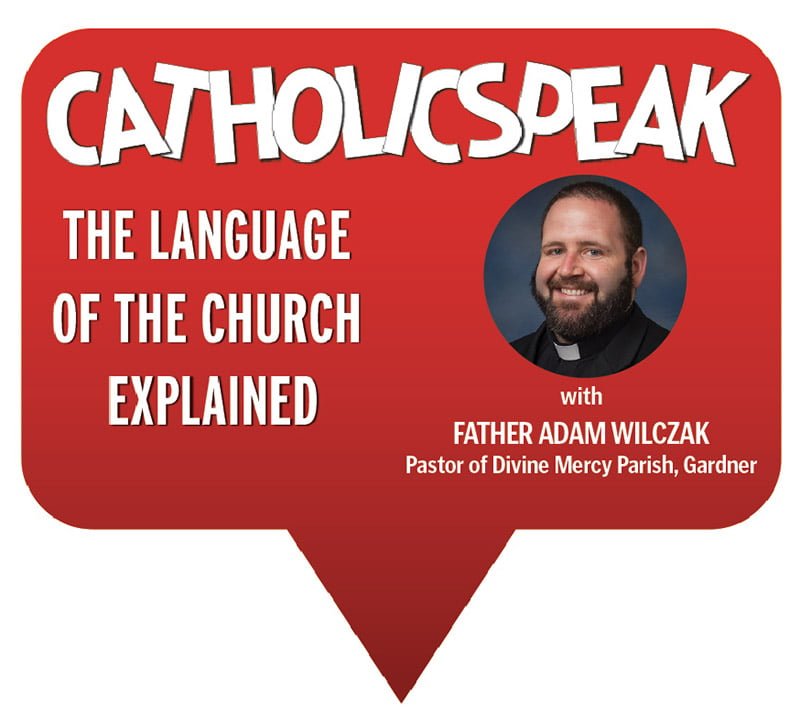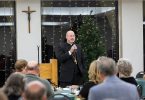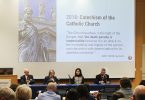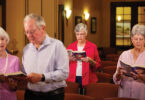
by Olivia Martin
olivia.martin@theleaven.org
It can seem daunting.
The Catechism of the Catholic Church goes to impressive lengths to compile and articulate the essential teachings of our ancient faith.
But its 800-plus pages are read more often in seminaries and rectories than they are in people’s living rooms.
And that’s a problem.
“One of the big struggles of our time is . . . we don’t know the faith very well,” said Father Adam Wilczak, pastor of Divine Mercy Parish in Gardner.
One of the best ways to change that, he suggests, “is to learn how to study, read on our own and take that into conversations with other people.”
Q: What is a catechism?
A: A catechism is a summary of essential and fundamental church doctrines. It is often used as an introduction to the sacraments and other church teachings or as a guide when answering questions about the faith.
Q: What role does the catechism play in the life of the church?
A: The catechism is a teaching tool — primarily for the bishops as teachers and pastors of the church.
It is also meant as a resource for teachers, catechists and priests — and anyone looking to know more about Catholic teachings and beliefs.
“It’s a good summary of our faith, of the key doctrines we hold close to us,” said Father Wilczak, “and it’s got a lot of good footnotes.
“It’s a great starting point if you have a question about what the church believes. You can go there and get a relatively quick answer, and it will also point you to other documents that will spend much more time exhausting it.”
Father Wilczak pointed out that as Catholics have started to grasp the faith on a wider, more intellectual level, the catechism has become a more popular tool.
“When I teach RCIA or other classes,” said Father Wilczak, “I try to get the catechism into other people’s hands and try to teach them how to look things up and use it as a tool themselves.”
Q: Many older Catholics are most familiar with the Baltimore Catechism, which they studied in grade school. What was its origin, and was it the first catechism of modern times?
A: The Baltimore Catechism is known as a “minor catechism.”
“It’s in a simple question- and-answer format with short answers to help us understand the fundamentals of the faith,” said Father Wilczak.
The Baltimore Catechism was the first catechism written for Catholics in the United States and was widely used from the 1880s to the 1960s.
Based on St. Robert Bellarmine’s 1614 “Short Catechism,” the Baltimore Catechism was mainly intended for teaching children the faith.
“The catechism we use now is a result of the Second Vatican Council,” said Father Wilczak. “St. John Paul II asked it be brought into existence.”
Father Wilczak said Vatican II produced lots of useful documents and helped breathe fresh air into Catholic theology. The updated version of the catechism was created to help all Catholics better apply the church’s teachings to modern times.
Q: How are Catholics to understand the relationship between the Baltimore Catechism and the current catechism today?
The main difference between the two lies in the level of detail it provides.
“Today’s catechism is a little more of an exhaustive level of teaching,” said Father Wilczak.
Since the release of the current catechism in 1992, supplementary catechetical texts have been released to increase the catechism’s accessibility.
For example, in 2005, “Compendium: Catechism of the Catholic Church” was released.
It’s written in Q&A format and is considered a hybrid between the Baltimore Catechism and the current catechism.
Also, in 2011, the YOUCAT — Youth Catechism of the Catholic Church — was published, offering the catechism in a format easily accessible to youth.
Q: How is the new catechism meant to be read? Do you read it from front to back? Or is it meant to be used as a reference book?
A: “Actually, you can do either,” said Father Wilczak. “A lot of times when I’m teaching it or introducing it to people, I use it as a reference book.
“But you can also read it front to back.”
Doing so gives you a good foundation, said Father Wilczak.
Q: How can the average Catholic benefit best from the catechism in his or her daily life?
A: “Just pick one up,” said Father Wilczak.
Father Wilczak also encouraged people to use it to prepare for Sunday Mass.
“In the readings there are always teachings from the Gospel . . . so look them up in the catechism. Just try to be active in expanding your knowledge.”
And he said to start conversations based on what you read in the catechism.
“Prayer and conversation are two great promptings to start to open up the book a little more often,” he said.
Q: If someone has never read from a catechism, which version would you recommend they start with?
A: “I recommend the big one,” said Father Wilczak. “Just like anything else we do in life, it might feel a little over our heads for a while, but the best way to get used to it is to wrestle with it.
“When we’re learning to walk, we do more falling than we do taking steps. Eventually, we learn how to walk.”
If you need help reading your catechism, Father Wilczak recommends asking a priest or an RCIA teacher to help.
“Try not to be intimidated,” he urged.
“Don’t be afraid to pick it up and fumble through it for a while,” he added.






